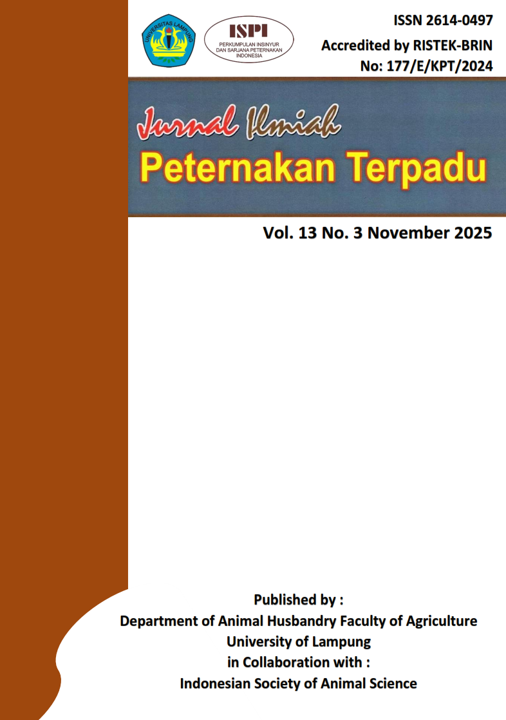Anatomical and Histological Features of the Tongue Wild Boar (Sus scrofa) from Timor Island
DOI:
https://doi.org/10.23960/jipt.v13i3.p875-888 Abstract View: 207
Abstract View: 207
Keywords:
lidah, babi hutan, anatomi, histologiAbstract
The tongue is a complementary organ owned by living things that easily moves and fills the oral cavity when the upper and lower jaw teeth meet. This study aims to determine the anatomical structure and histology of the tongue in wild boar (Sus scrofa) from the Island of Timor. Tongue organs were collected from three healthy wild boars. Animals were slaughtered and necropsied. Macroscopic observations were made; length, width, and thickness were measured, and the tongue tissue was cut into several parts, namely the apex lingua, corpus lingua, and radix lingua, to be fixed in 10% formalin. Furthermore, Hematoxylin-Eosin (HE) staining was performed. The results showed that the dorsal surface has four types of papillae, namely circumvallate papillae, conical papillae, foliate papillae, fungiform papillae, and filiform papillae. The tongue muscles of wild boar were found to be m. longitudinalis, m. transversus, and m. verticalis. Conical papillae are conical with a blunt tip. Foliate papillae are located on the lateral-radix of the tongue. Fungiform papillae have a dome-like oval shape. Filiform papillae have an elongated cylindrical shape with a blunt tip. The size of the filiform papillae at the corpus of the tongue is larger than at the apex of the tongue.
Downloads
References
Al-Jumaily, Iman Sami Ahmed., Ibrahim, Marwa Khalil & Abid, Wijdan Bashir. (2021). Histological structure of the Tongue in Mongoose (Herpestes javanicus). Journal of Physics: Conference Series. 1-10.
Ateş, S., Akaydin Bozkurt, Y. A., Kozlu, T., Alan, A., & Düzler, A. (2013). Light and scanning electron microscopic studies on the lingual papillae of 80-dayold wild pig fetal siblings. Turkish Journal of Veterinary and Animal Sciences, 37(6), 664–671. https://doi.org/10.3906/vet-1210-5.
Bhamburkar, V. R. (2021). Veterinary Anatomy the Regional Gross Anatomy of Domestic Animals. Nipa.
Dellman, Eurell, J., & Frappier, B. L. (2006). Dellmann’s Textbook of Veterinary Histology, 6th Edition.
Goździewska-Harłajczuk, Karolina, Joanna Klećkowska-Nawrot, Karolina Barszcz, Krzysztof Marycz, Tomasz Nawara, Klaudia Modlińska, and Rafał Stryjek. 2018. “Biological Aspects of the Tongue Morphology of Wild-Captive WWCPS Rats: A Histological, Histochemical and Ultrastructural Study.” Anatomical Science International 93(4):514–32. doi: 10.1007/s12565-018-0445-y.
Haggag, T., Mahmoud, E. F., Salem, Z. A., & AbuBakr, N. (2020). Comparative evaluation of the ultrastructural morphology and distribution of filiform and fungiform tongue papillae in Egyptian mice, fruit bats and long-eared hedgehogs. Anatomy and Cell Biology, 53(4), 493–501. https://doi.org/10.5115/acb.20.173.
Iwasaki, S. (2002). Evolution of the Structure and Function of the Vertebrate Tongue. J. Anat, 201, 1–13.
König, H. E., & Liebich, H.-G. (2020). Veterinary Anatomy of Domestic Animals: Textbook and Colour Atlas, 7th Edition.
Kumar, S., dan Bate, L. A. (2004). Scanning electron microscopy of the tongue papillae in the pig (Sus scrofa). Microscopy Research and Technique, 63(5), 253–258. https://doi.org/10.1002/jemt.20036.
Kumar, P., & Kumar, P. (2012). Light and Scanning Electron Microscopic Studies on the Tongue of Adult Pig. 1. Gustatory Papillae. Indian Journal of Animal Sciences, 82(1), 34–39.
Lee, S., & Lee, E. (2019). Diet of the Wild Boar ( Sus scrofa ): Implications for Management in Forest-agricultural and Urban Environments in South Korea. Peer J, 7:e783, 1–16. https://doi.org/10.7717/peerj.7835
Liebich, H.-G. (2019). Veterinary Histology of Domestic Mammals and Birds, 5th Edition.
Muntiha, M. (2001). Teknik Pembuatan Preparat Histologi dari Jaringan Hewan dengan Pewarnaan Hematoksilin dan Eosin (H&E). Temu Teknis Fungsional Non Peneliti, 156–163.
Murad, N. A., Hassan, N. H., & Abid, T. A. (2010). Anatomical Study of the Tongue in Adult Rams. Kufa Journal For Veterinary Medical Sciences, 2(1), 48–57
Muttaqien, Balqis, U., & Silvina, R. (2018). Histopatological of Tongues Wild Boar Infected by Endoparasites in Lhoknga Aceh Besar. JIMVET, 2(4) ;584 – 592.
Sugiharto, Widiastuti, dan Wahyuni. (2021). Buku Ajar Fisiologi Ternak. Semarang. UNDIP PRESS.
Suripto, B. A. (2000). Babi Hutan (Sus spp.) di Pulau Jawa: Masa Lalu, Masa Kini, dan Masa yang Akan Datang. Jurnal Konservasi Kehutanan, 2(1), 1– 23.
Reginato, Barbosa, Ferreira, Vasconcelos, Rici, Watanabe, & Ciena, A. (2020). Morphological and Ultrastructural Characteristics of the Tongue of Wild Boar. European Journal of Histochemistry, 64, 156 –163.
Rizki Albert, W., Rizaldi, & Nurdin, J. (2014). Karakteristik Kubangan dan Aktivitas Berkubang Babi Hutan (Sus scrofa L.) di Hutan Pendidikan dan Penelitian Biologi (HPPB) Universitas Andalas The. Jurnal Biologi Universitas Andalas (J. Bio. UA.). 3(3), 195–201.
Yulianti, T., Samsugi, S., Agung, P., & Harry, A. (2021). Rancang Bangun Alat Pengusir Hama Bani Menggunakan Arduino dengan Sensor Gerak, JTST, 2(1) ; 21 - 27.
Downloads
Published
How to Cite
Issue
Section
License
Copyright (c) 2025 Aurelia Bebonita Harum, Inggrid Trinidad Maha, Heny Nitbani, Filphin Adolfin Amalo, Yulfia Nellymalik Selan, Jois Moriani Jacob

This work is licensed under a Creative Commons Attribution 4.0 International License.

Jurnal Ilmiah Peternakan Terpadu(JIPT) is licensed under a Creative Commons Attribution 4.0 International License.
Authors who publish with this journal agree to the following terms:
- Authors retain copyright and grant the journal right of first publication with the work simultaneously licensed under a Creative Commons Attribution License that allows others to share the work with an acknowledgement of the work's authorship and initial publication in this journal.
- Authors are able to enter into separate, additional contractual arrangements for the non-exclusive distribution of the journal's published version of the work (e.g., post it to an institutional repository or publish it in a book), with an acknowledgement of its initial publication in this journal.
- Authors are permitted and encouraged to post their work online (e.g., in institutional repositories or on their website) prior to and during the submission process, as it can lead to productive exchanges, as well as earlier and greater citation of published work (See The Effect of Open Access).





















